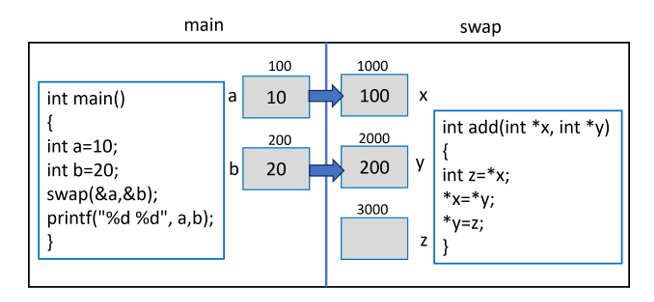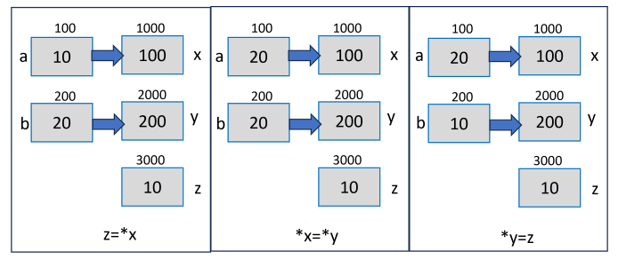
- C程式設計教程
- C - 首頁
- C語言基礎
- C - 概述
- C - 特性
- C - 歷史
- C - 環境設定
- C - 程式結構
- C - Hello World
- C - 編譯過程
- C - 註釋
- C - 詞法單元
- C - 關鍵字
- C - 識別符號
- C - 使用者輸入
- C - 基本語法
- C - 資料型別
- C - 變數
- C - 整數提升
- C - 型別轉換
- C - 型別強制轉換
- C - 布林值
- C語言中的常量和字面量
- C - 常量
- C - 字面量
- C - 轉義序列
- C - 格式說明符
- C語言中的運算子
- C - 運算子
- C - 算術運算子
- C - 關係運算符
- C - 邏輯運算子
- C - 位運算子
- C - 賦值運算子
- C - 一元運算子
- C - 自增和自減運算子
- C - 三元運算子
- C - sizeof運算子
- C - 運算子優先順序
- C - 其他運算子
- C語言中的決策
- C - 決策
- C - if語句
- C - if...else語句
- C - 巢狀if語句
- C - switch語句
- C - 巢狀switch語句
- C語言中的迴圈
- C - 迴圈
- C - while迴圈
- C - for迴圈
- C - do...while迴圈
- C - 巢狀迴圈
- C - 無限迴圈
- C - break語句
- C - continue語句
- C - goto語句
- C語言中的函式
- C - 函式
- C - 主函式
- C - 值傳遞
- C - 引用傳遞
- C - 巢狀函式
- C - 可變引數函式
- C - 使用者自定義函式
- C - 回撥函式
- C - 返回語句
- C - 遞迴
- C語言中的作用域規則
- C - 作用域規則
- C - 靜態變數
- C - 全域性變數
- C語言中的陣列
- C - 陣列
- C - 陣列的特性
- C - 多維陣列
- C - 將陣列傳遞給函式
- C - 從函式返回陣列
- C - 可變長陣列
- C語言中的指標
- C - 指標
- C - 指標和陣列
- C - 指標的應用
- C - 指標運算
- C - 指標陣列
- C - 指標到指標
- C - 將指標傳遞給函式
- C - 從函式返回指標
- C - 函式指標
- C - 指向陣列的指標
- C - 指向結構體的指標
- C - 指標鏈
- C - 指標與陣列
- C - 字元指標和函式
- C - 空指標
- C - void指標
- C - 野指標
- C - 解引用指標
- C - 近指標、遠指標和巨型指標
- C - 指標陣列的初始化
- C - 指標與多維陣列
- C語言中的字串
- C - 字串
- C - 字串陣列
- C - 特殊字元
- C語言中的結構體和聯合體
- C - 結構體
- C - 結構體和函式
- C - 結構體陣列
- C - 自引用結構體
- C - 查詢表
- C - 點(.)運算子
- C - 列舉(或enum)
- C - 結構體填充和打包
- C - 巢狀結構體
- C - 匿名結構體和聯合體
- C - 聯合體
- C - 位域
- C - Typedef
- C語言中的檔案處理
- C - 輸入和輸出
- C - 檔案I/O(檔案處理)
- C預處理器
- C - 預處理器
- C - 預處理指令
- C - 預處理器運算子
- C - 宏
- C - 標頭檔案
- C語言中的記憶體管理
- C - 記憶體管理
- C - 記憶體地址
- C - 儲存類
- 其他主題
- C - 錯誤處理
- C - 可變引數
- C - 命令執行
- C - 數學函式
- C - static關鍵字
- C - 隨機數生成
- C - 命令列引數
- C程式設計資源
- C - 問答
- C - 快速指南
- C - 速查表
- C - 有用資源
- C - 討論
C語言中的引用呼叫
函式的呼叫方式有兩種:(a) 值傳遞和 (b) 引用傳遞。在本節中,我們將解釋引用傳遞的機制。
讓我們從簡要概述“指標”和“地址運算子(&)”開始本節。學習這兩個概念對於充分理解引用傳遞的機制非常重要。
C語言中的地址運算子(&)
在C語言中,變數是命名記憶體位置。當宣告變數時,編譯器會在記憶體中分配一個隨機位置,並在內部使用使用者定義的名稱來標識該位置。
要獲取變數建立的地址,我們使用地址(&)運算子。
示例
請看下面的例子 -
#include <stdio.h>
int main(){
int x = 10;
printf("x: %d Address of x: %d", x, &x);
}
輸出
這將列印x的值及其地址 -
x: 10 Address of x: -1990957196
什麼是C語言中的指標?
指標是一個儲存另一個變數地址的變數。要宣告指標變數,其名稱字首為*符號。指標變數和其宿主變數的型別必須相同。
地址由&運算子分配。解引用運算子(*)與指標一起使用。它獲取地址分配給指標的變數的值。
示例
下面的例子演示了C語言中引用和解引用的工作方式 -
#include <stdio.h>
int main(){
int x = 10;
int *y = &x;
printf("x: %d Address of x: %d\n", x, &x);
printf("Address of y: %d \n", &y);
printf("Value at address in y: %d\n", *y);
}
輸出
執行程式碼並檢查其輸出 -
x: 10 Address of x: -1742755108 Address of y: -1742755104 Value at address in y: 10
C語言中的引用傳遞是如何工作的?
當函式被引用呼叫時,傳遞的是實際引數變數的地址,而不是它們的值。
讓我們定義接收兩個變數引用的add()函式 -
int add(int *x, int *y){
int z = *x + *y;
return z;
}
當呼叫這樣的函式時,我們傳遞實際引數的地址。
示例
讓我們從main()函式內部透過引用呼叫add()函式 -
#include <stdio.h>
/* function declaration */
int add(int *, int *);
int main(){
int a = 10, b = 20;
int c = add(&a, &b);
printf("Addition: %d", c);
}
int add(int *x, int *y){
int z = *x + *y;
return z;
}
輸出
當您執行此程式碼時,它將產生以下輸出 -
Addition: 30
現在讓我們瞭解這段程式碼是如何工作的。main()函式將a和b的地址傳遞給add()函式。a和b的地址被分配給指標變數x和y。
現在關注add()函式內部的語句“z = *x + *y;”。請記住,x儲存a的地址。*x和*y中的解引用運算子分別獲取a和b的值,因此z是main()函式中a和b的和。
示例:使用引用傳遞交換值
讓我們藉助以下交換兩個變數值的示例,更詳細地瞭解引用傳遞機制的工作原理。
#include <stdio.h>
/* Function definition to swap the values */
/* It receives the reference of two variables whose values are to be swapped */
int swap(int *x, int *y){
int z;
z = *x; /* save the value at address x */
*x = *y; /* put y into x */
*y = z; /* put z into y */
return 0;
}
/* The main() function has two variables "a" and "b" */
/* Their addresses are passed as arguments to the swap() function. */
int main(){
/* local variable definition */
int a = 10;
int b = 20;
printf("Before swap, value of a: %d\n", a );
printf("Before swap, value of b: %d\n", b );
/* calling a function to swap the values */
swap(&a, &b);
printf("After swap, value of a: %d\n", a);
printf("After swap, value of b: %d\n", b);
return 0;
}
輸出
當您執行此程式碼時,它將產生以下輸出 -
Before swap, value of a: 10 Before swap, value of b: 20 After swap, value of a: 20 After swap, value of b: 10
解釋
假設main()函式中的變數a和b分別分配了記憶體地址100和200。由於它們的地址被傳遞給x和y(請記住它們是指標),因此swap()函式中的變數x、y和z分別在地址1000、2000和3000處建立。

由於“x”和“y”儲存“a”和“b”的地址,“x”變為100,“y”變為200,如上圖所示。
在swap()函式內部,第一條語句“z = *x”導致“x”中地址處的值儲存在“x”(即10)中。類似地,在語句“*x = *y;”中,將“y”中地址處的值(即20)儲存在指標為“x”的位置中。
最後,語句“*y = z;”將“z”賦值給“y”指向的變數,即main()函式中的“b”。現在,“a”和“b”的值被交換了。
下圖直觀地演示了它是如何工作的 -

混合使用值傳遞和引用傳遞
您可以使用值傳遞和引用傳遞的組合作為函式呼叫機制。它可以被稱為“混合呼叫機制”,其中一些引數透過值傳遞,其他引數透過引用傳遞。
C語言中的函式可以有多個引數,但只能返回一個值。引用傳遞機制是克服此限制的一個好方法。
示例
在此示例中,calculate()函式透過值接收整數引數,並接收兩個指標,其中儲存其平方和立方。
#include <stdio.h>
#include <math.h>
/* function declaration */
int calculate(int, int *, int *);
int main(){
int a = 10;
int b, c;
calculate(a, &b, &c);
printf("a: %d \nSquare of a: %d \nCube of a: %d", a, b, c);
}
int calculate(int x, int *y, int *z){
*y = pow(x,2);
*z = pow(x, 3);
return 0;
}
輸出
當您執行此程式碼時,它將產生以下輸出 -
a: 10 Square of a: 100 Cube of a: 1000
當函式需要執行記憶體級操作(例如控制外圍裝置、執行動態分配等)時,廣泛使用引用傳遞機制。